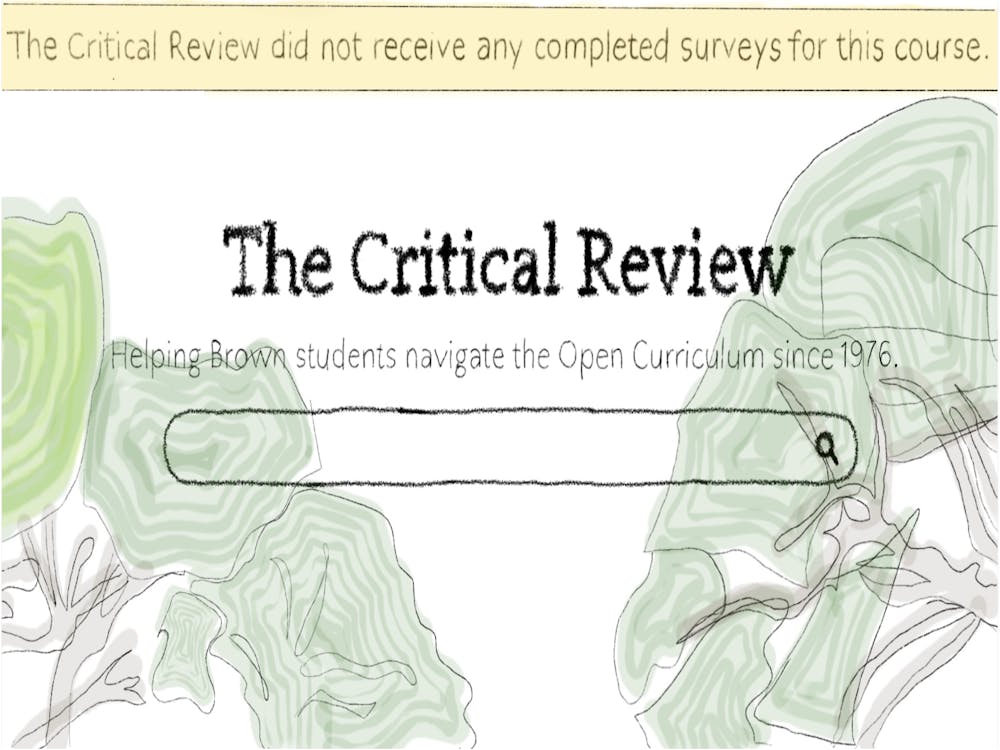Imagine this: Shopping period is ending soon. After an hours-long search for another course to add to your schedule, you seem to have found the one. But how will you know whether it’s the best course for you?
Like other Brown students, you may turn to the Critical Review: A student-run organization that produces course reviews based on data compiled and summarized from surveys sent to students about courses offered at Brown, according to their website. But, declining student participation in the organization’s surveys “has made it difficult for us to continue our work,” Elli Clerides ’24, Critical Review executive board member, wrote in an email to The Herald.
Writers compose reviews when a course’s survey has received responses from at least three students, according to Critical Review data shared with The Herald. The reviews are then subject to three rounds of editing, “during which they are checked for accuracy and objectivity,” according to the organization’s website.
Based on data from the Critical Review, the organization only received enough student responses to review “a maximum of 154 courses” offered in fall 2023. In fall 2020, the organization received responses to provide evaluations for 252 courses.
According to Clerides, the Critical Review experienced a significant decline in student participation in their survey after the COVID-19 pandemic.
In fall 2023, 287 instructors, from a list of 1,289 graduate and undergraduate courses provided to the organization by the registrar, opted into administering the Review’s surveys, according to the organization’s data.
Professors have the option to opt in to administer the surveys to their students at the end of the semester, according to the website. Critical Review staff told The Herald that professors are supplied with a unique link they can choose to forward to their students.
Co-editor-in-chief Zoey Grant ’24 said she fears a “self-fulfilling cycle”: When students do not fill out the surveys, it disincentivizes professors from administering them in the future because of the lack of responses.
Ryan Peng ’25, a current editor at the publication, said the surveys are distributed “at a really unfortunate time” — at the end of the semester when students have finals and “might not write that much because they have a lot of things going on.”
Nicole Gonzalez Van Cleve, a professor of sociology who began teaching at Brown in 2019, hasn’t opted in to share the surveys with her students because she “honestly didn’t know much about it,” she told The Herald. She added that she “would love to learn more” about the publication.
“If the Critical Review can talk to more new faculty, that would be wonderful,” Gonzalez Van Cleve said, adding that faculty who began at Brown right before COVID-19 “didn’t have enough time to learn all the rules of engagement and why the Critical Review was so important to students and maybe even faculty.”
“The Critical Review does reach out to new professors (and) new classes to try to get their participation,” Peng said. “But again, it’s an opt-in system.”
Gonzalez Van Cleve also noted — as does the Critical Review website’s FAQ — that student biases regarding gender, race and other factors can lead to lower ratings in course evaluations. The Review’s website links to a Cambridge University Press 2019 research paper which found that female and persons of color instructors “receive lower scores on ordinal student evaluations” than white male instructors.
According to the Review’s website, “the Critical Review constantly strives to write unbiased and accurate reviews.”
“I think that one thing that students really want is for us to give the raw feedback,” said Eric Cho ’26, a member of the Critical Review’s executive board. But the Review “aggregates all the feedback in such a way that it can be interpreted by anyone” and to “filter the bias,” he said.
He explained that student surveys are anonymized for Critical Review writers, who are trained to maintain a consistent writing style.
Gonzalez Van Cleve suggested that the Critical Review reassure professors that the publication protects student privacy and clarify the difference between their surveys and University-administered course feedback surveys. Brown’s course feedback surveys are administered on Canvas and are separate from the Critical Review’s course evaluations.
In order to offer reviews to students, the Critical Review “must meet certain conditions as part of our agreement with Brown,” which includes following the opt-in system, according to their website’s FAQ.
For Professor of Biology Sohini Ramachandran, who has provided her BIOL 0495: “Statistical Analysis of Biological Data” and BIOL 1465: “Human Population Genomics” classes with the chance to fill out the Critical Review’s surveys, the publication helps students to make informed decisions about courses, she said.
Ramachandran has also found the Critical Review useful as an instructor, specifically because their reviews “have offered me feedback on how I construct assessments and exams,” and “given me a little more insight into the different backgrounds of students who might consider taking my course.”
Grant partly attributes the Critical Review’s declining student response rates to the fact that students might not recognize that their reviews “can change things about courses or help other students,” she said.
Critical Review co-editor-in-chief Jasmine Shum ’24 outlined ongoing efforts “to enliven the spirit of the Critical Review,” including polling the undergraduate student body about what randomly distributed prizes they might want each semester after filling out the surveys.
Additionally, a new Critical Review website is being developed, Shum shared. The new website will likely maintain the design elements of the current website and incorporate “fun, more interactive features” such as search filters and relevant course recommendations, she added.
Grant said the Critical Review is also reconsidering some of its questions and working on outreach. “We really want to emphasize to students, ‘Hey, we’re a student-run organization. We need you (and your feedback), or you won’t be able to have this resource eventually,’” she said.

Kate Rowberry is a senior staff writer at The Herald.





